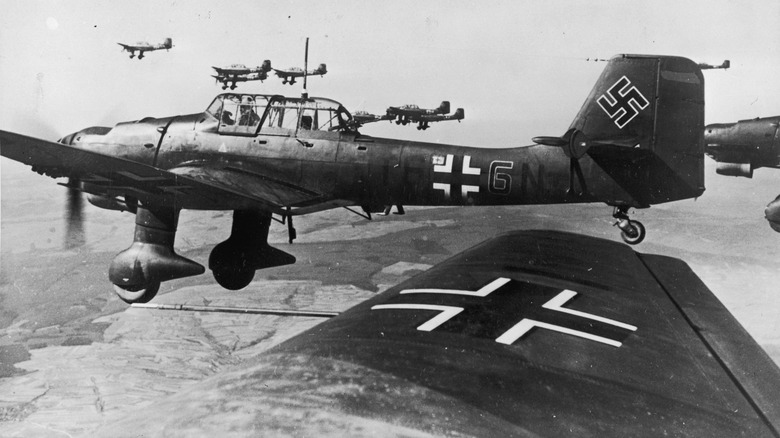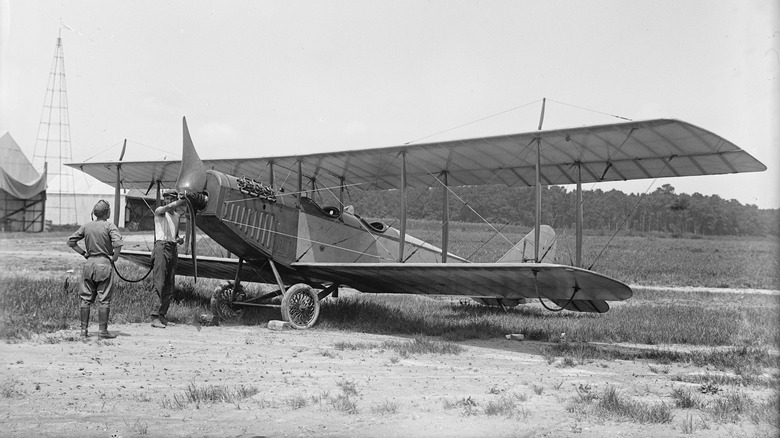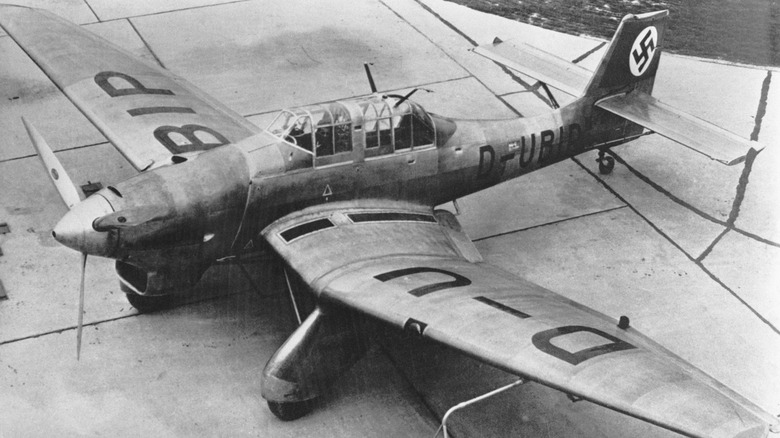Here's What Made The Stuka Ju-87 So Good
One of the Nazi's most emblematic pieces of military ordnance, and perhaps the most feared plane of World War II, was the "Screaming Bird of Prey" — the Junkers Ju-87. It's better known as a "Stuka," short for Sturzkampfflugzueg — the German word for dive bomber.
The plane that resembled a "flying swastika" had a terrifying banshee wail and several innovative systems that, when combined, struck as much psychological fear into the hearts of the enemy as it did physical damage. While its golden era of terror was a short-lived four years from 1939 to 1943, the aircraft was born much earlier.
To understand just how good the Ju-87 was compared to other dive bombers of the era, we need to go back to the beginning of air warfare, which more or less began a decade earlier.
The first historically recognized "preplanned and practiced dive-bombing attack" occurred in 1918. The U.S. Army Air Forces' 2nd Lt. Henry Brown, who almost become a Double Ace during WWII, was flying a British-made Royal Aircraft Factory S.E. 5a when he came across German supply ships cruising a canal in France. Brown locked on a target, dove and dropped a fragmentation bomb, victoriously sinking the ship.
British military forces mimicked this style until they attempted an attack on ground forces, which failed so profoundlythey immediately ceased. But the American pressed on.
Americans helped perfect the art of dive-bombing
Early in 1919, as part of the American force that invaded Haiti, Marine Corps pilot Lt. Lawson Sanderson used a canvas bag to hold a bomb in place on the underside of his Curtis JN-4 "Jenny" aircraft and began dive-bombing with success. The U.S. also flew British-designed, American-made de Havilland DH-4s during the same conflict.
Later that same year, the Army Air Forces showed off improved dive-bombing techniques likely gleaned from Sanderson's feats. Shortly after that, it was used along the border during the Mexican Revolution. Ironically, the first recognized aerial combat scenario took place during the same conflict six years earlier in 1913 when two American pilots fighting on opposite sides shot at each other in mid-air with, of all things, revolvers.
In 1926, the commanding officer for a Naval strike squadron began teaching his squad dive-bombing techniques. They coordinated a fake attack on ships in the fleet using a Curtiss F6C-2 to prove the soundness of the strategy. This demonstration convinced the Navy to design a biplane — the Martin XT5M-1 – made explicitly to survive steep dives at terminal velocity with a massive bomb still stuck to its belly.
The U.S. used dive-bombers again in 1927 and 1928 while fighting the "Sandinistas" in Nicaragua. In short, the United States unabashedly favored this new form of aerial combat with vim and vigor wherever possible. And it did not go unnoticed by Germany.
The Stuka was a deep diving Junker
In the 1930s, Adolf Hitler was hell-bent on rebuilding Germany's military might, and the dive bomber was an integral part. Ernst Udet, an ace credited with shooting down 62 enemy aircraft during World War I, was a big proponent, allegedly having seen the Curtiss F11C-2 Goshawk in action at an air race in Cleveland, Ohio. Hermann Göering brought two Goshawks in for evaluation.
Meanwhile, the Junkers aircraft company, which was located in Sweden to bypass the Treaty of Versaille, was working on a single-wing prototype called the K 47 that could successfully perform a 90-degree dive. Between 1931 and 1934, the K 47 went through many different iterations and proved incredibly accurate. In 1935, a Stuka prototype, designed by Hugo Junkers, with a Rolls Royce engine took off on its first test flight.
What made the Ju-87 different was the dive brakes, invented by Junkers, that slowed the dive long enough for the pilot to line up the plane. After all, the whole advantage of a dive bomber is its ability to be pinpoint accurate, and a bomb dropped from an aircraft in a true vertical dive would end up precisely where the plane was pointed.
Air Force Times reported that Brown called the "Ju-87 was a genuine 90-degree screamer." Almost every other bomber couldn't make it past 70 degrees, thus skewing accuracy considerably.
The haunting scream of the Ju-87 lives on
While it's the very thing that made Stukas a legendary WWII plane and much better than all other diver bombers at the time, other innovations helped. The "Stuka-vizier," also allowed pilots to accurately zero in on their targets.
The Stuka's attacks were so accurate that some sources claim most drops were "you sunk my battleship"-type direct hits. Even "bad" ones often landed relatively close to the intended targets. It was also equipped with an automated pullout feature that activated if the pilot became unexpectedly incapacitated during the dive. Most pilots didn't trust it enough to actually use it, though.
Then there was the infamous scream, made even more famous by movie reels from the era and later by Hollywood. The sound's psychological impact would often cause panic and chaos, a tactic that actually proved as valuable as the Stuka's physically destructive capacity.
The Ju-87 dropped its first bombs over Poland in 1939, and remained a vital cog in the Nazi war machine until its very last flight on May 4, 1945.


